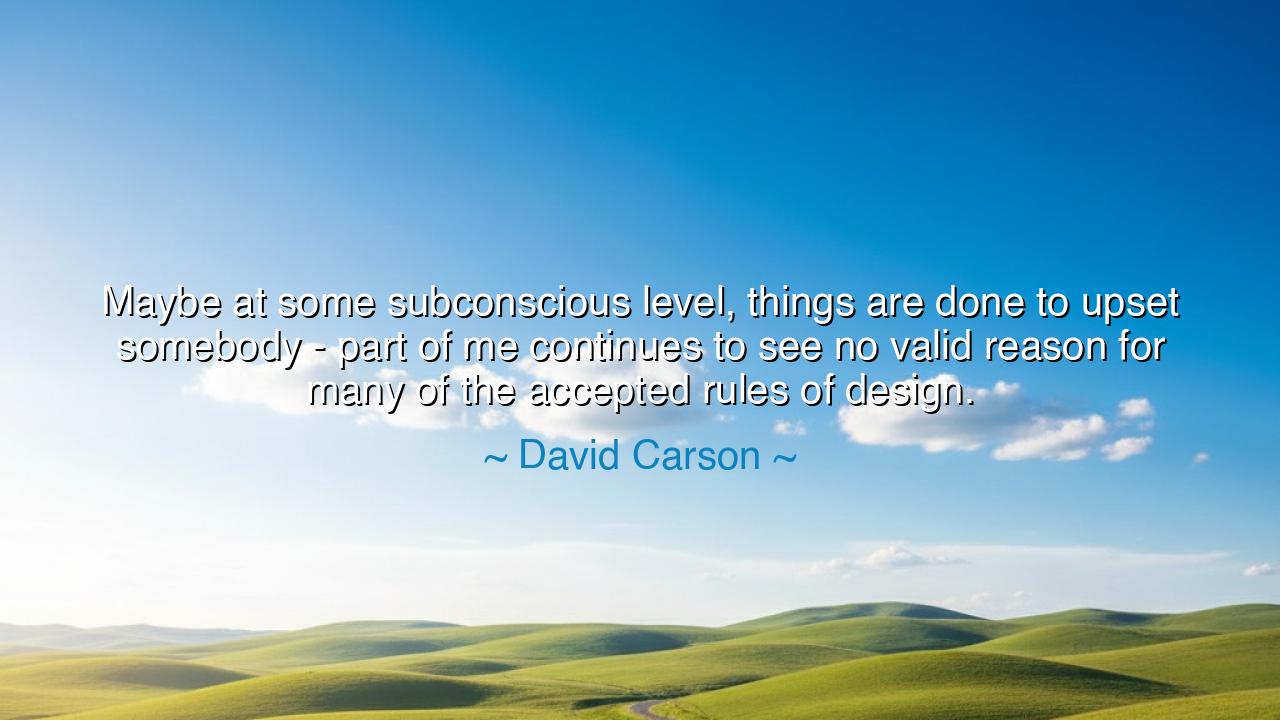
Maybe at some subconscious level, things are done to upset
Maybe at some subconscious level, things are done to upset somebody - part of me continues to see no valid reason for many of the accepted rules of design.






David Carson, the great iconoclast of modern design, once declared: “Maybe at some subconscious level, things are done to upset somebody – part of me continues to see no valid reason for many of the accepted rules of design.” In this confession lies not rebellion for its own sake, but the eternal cry of the creator who refuses to bow before convention. His words are a hymn to the restless spirit — the part of the artist that cannot live within the boundaries drawn by others, that seeks not to follow, but to question, provoke, and awaken. Through his art, Carson reminds us that progress is not born of obedience, but of defiance guided by vision.
The meaning of this quote unfolds in the tension between order and chaos, between tradition and invention. Carson speaks as one who has walked the edge — the narrow path where art ceases to imitate and begins to redefine. The “accepted rules of design” are, to him, not sacred laws, but habits mistaken for truth. They may have once served a purpose, but over time they become chains that bind imagination. To reject them is not arrogance, but the natural act of evolution — the same impulse that drove the sculptors of Greece to break from geometry to carve movement, or the painters of the Renaissance to embrace depth and light. In every age, the artist must tear down a wall to build a new world.
Carson’s origin in this philosophy lies in his life as a surfer turned graphic designer — a man shaped not by academic training but by the wild rhythm of the waves. In the 1990s, his designs for Ray Gun magazine shattered every rule of typography and composition. Text overlapped, images collided, order dissolved into expressive chaos — and yet, it spoke with the raw pulse of truth. Critics called his work “illegible,” but to a generation, it felt alive. Carson understood that art is not meant to comfort the eye, but to stir the soul. His rebellion was not against structure, but against stagnation. To upset “somebody,” as he said, was not mischief — it was awakening.
History offers many mirrors to Carson’s creed. When Vincent van Gogh smeared his soul across the canvas with colors that defied realism, he was condemned by his peers. His paintings broke every rule of form, proportion, and polish — yet today, his brushstrokes move the world with their honesty. So too with Igor Stravinsky, whose Rite of Spring caused riots for its dissonance, only to become the heartbeat of modern music. Each of these visionaries carried within them the same impulse Carson describes — that subconscious need to unsettle. For the artist who does not disturb the comfortable, merely decorates the status quo.
But Carson’s words reach beyond design; they speak to the human condition itself. For in every soul lies the conflict between obedience and authenticity. Society teaches rules — of thought, of behavior, of belief — and those who break them risk isolation. Yet it is through such breaking that civilizations are reborn. The prophets, the philosophers, the inventors, and the dreamers all shared this quiet madness — the conviction that truth lies beyond tradition. To question the “accepted rules” of any field, be it art, science, or life, is to honor the living spirit of creation.
Still, Carson’s wisdom carries both fire and humility. He does not claim that rebellion should be reckless; he speaks of a “subconscious level,” a deep instinct that guides the true creator. This is not destruction for vanity’s sake, but transformation born of sincerity. The artist must first know the rules before breaking them — must understand the form before setting it free. Only then can the act of defiance become meaningful, not random. For rebellion without purpose is noise, but rebellion with heart is revelation.
The lesson, then, is this: do not fear the gaze of those who call you wrong, strange, or disobedient. The world advances because of those who dare to ask why when others say “because.” If you feel the pull to challenge the patterns that surround you — in art, in work, in life — honor it. But let that defiance come from truth, not ego; from the desire to express, not to impress. Be brave enough to upset comfort, and wise enough to know why.
So remember, my children of creation: rules are the bones of art, but rebellion is its breath. Without breath, the form is lifeless. Without challenge, beauty becomes repetition. As David Carson taught us, there is no valid reason to follow blindly — for the act of questioning, of pushing, of creating anew, is the very essence of being alive. Let your work — and your life — disturb the silence of conformity, and through that disturbance, let something greater be born.






AAdministratorAdministrator
Welcome, honored guests. Please leave a comment, we will respond soon